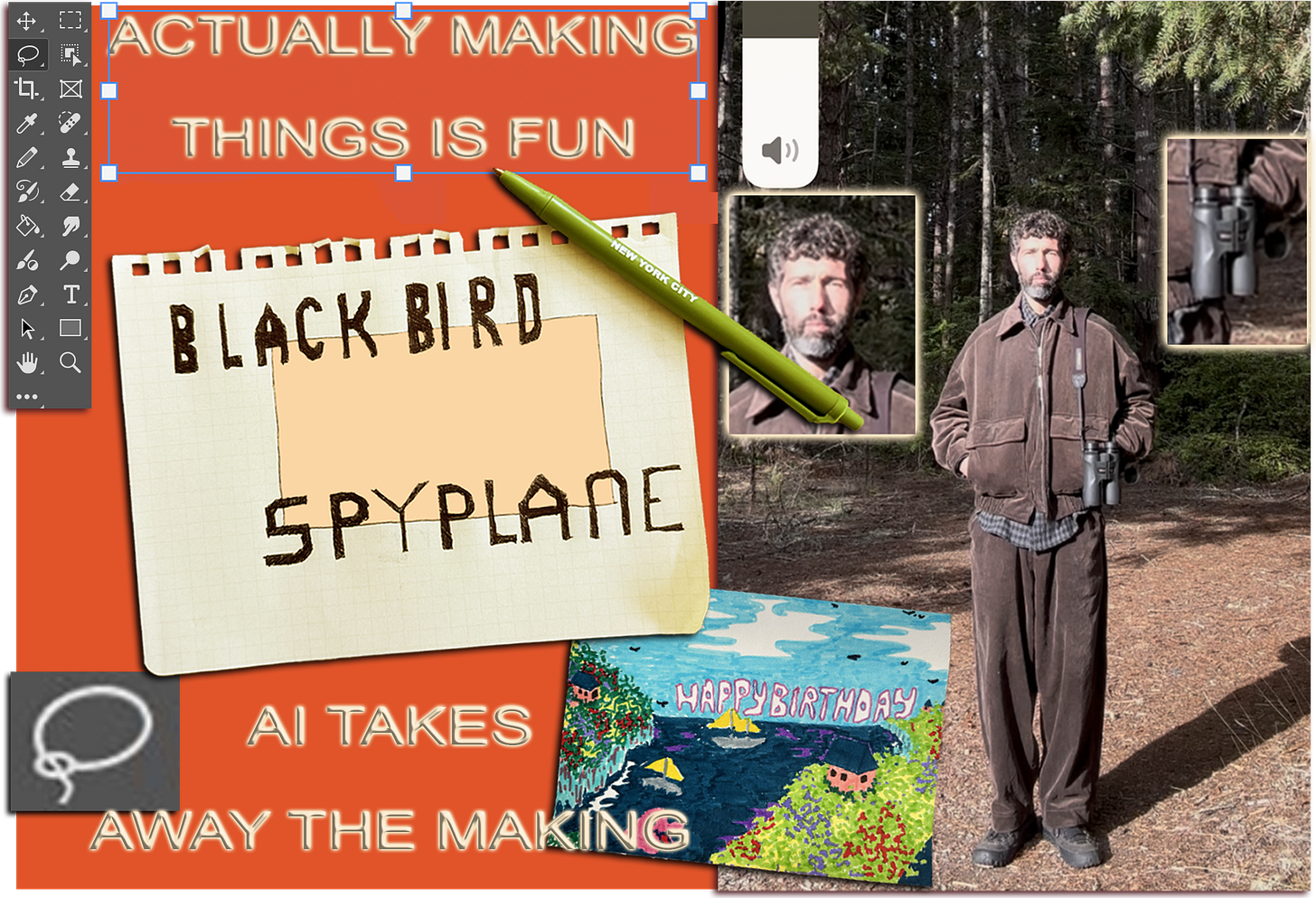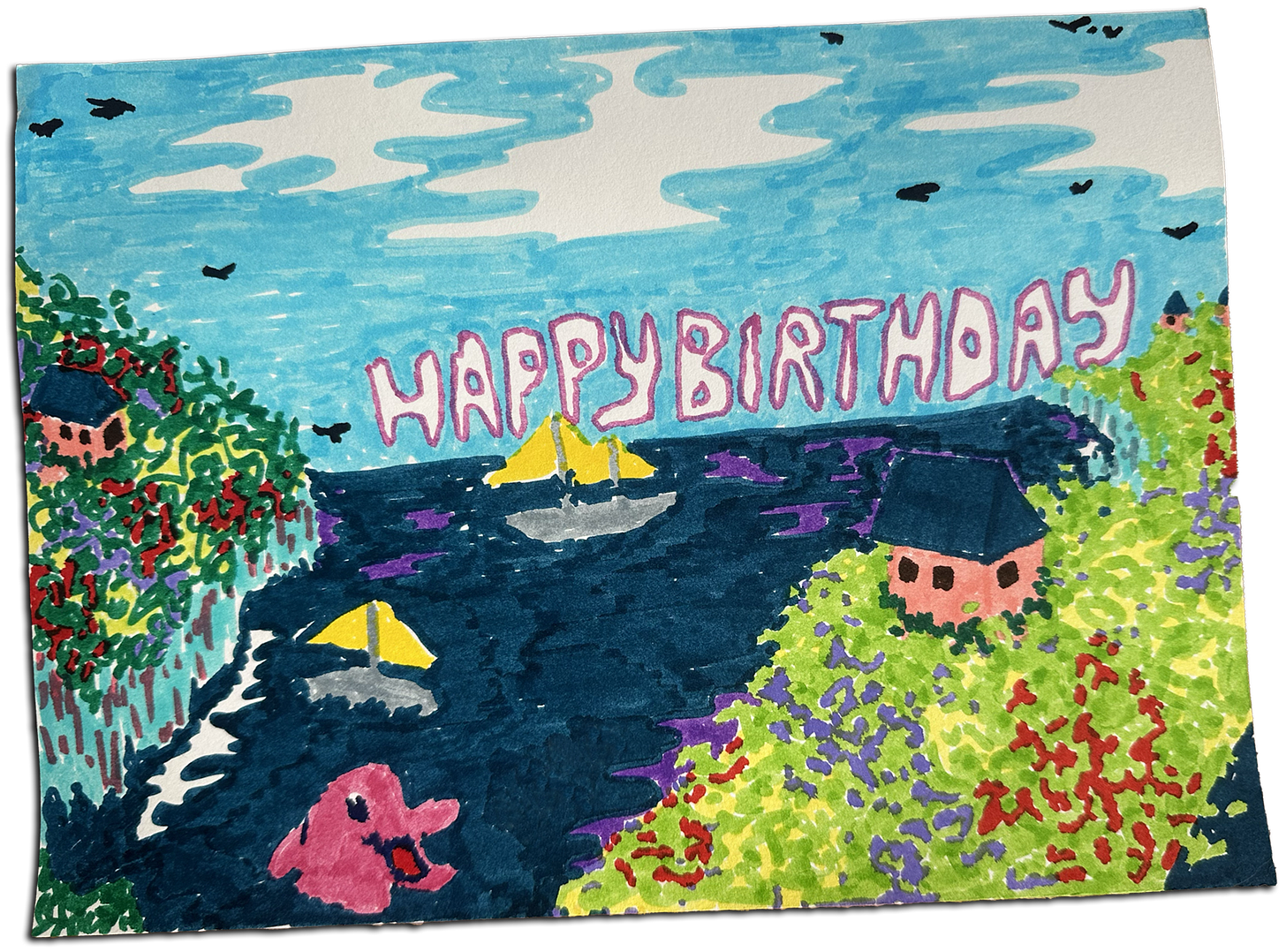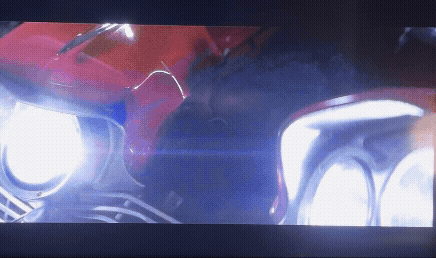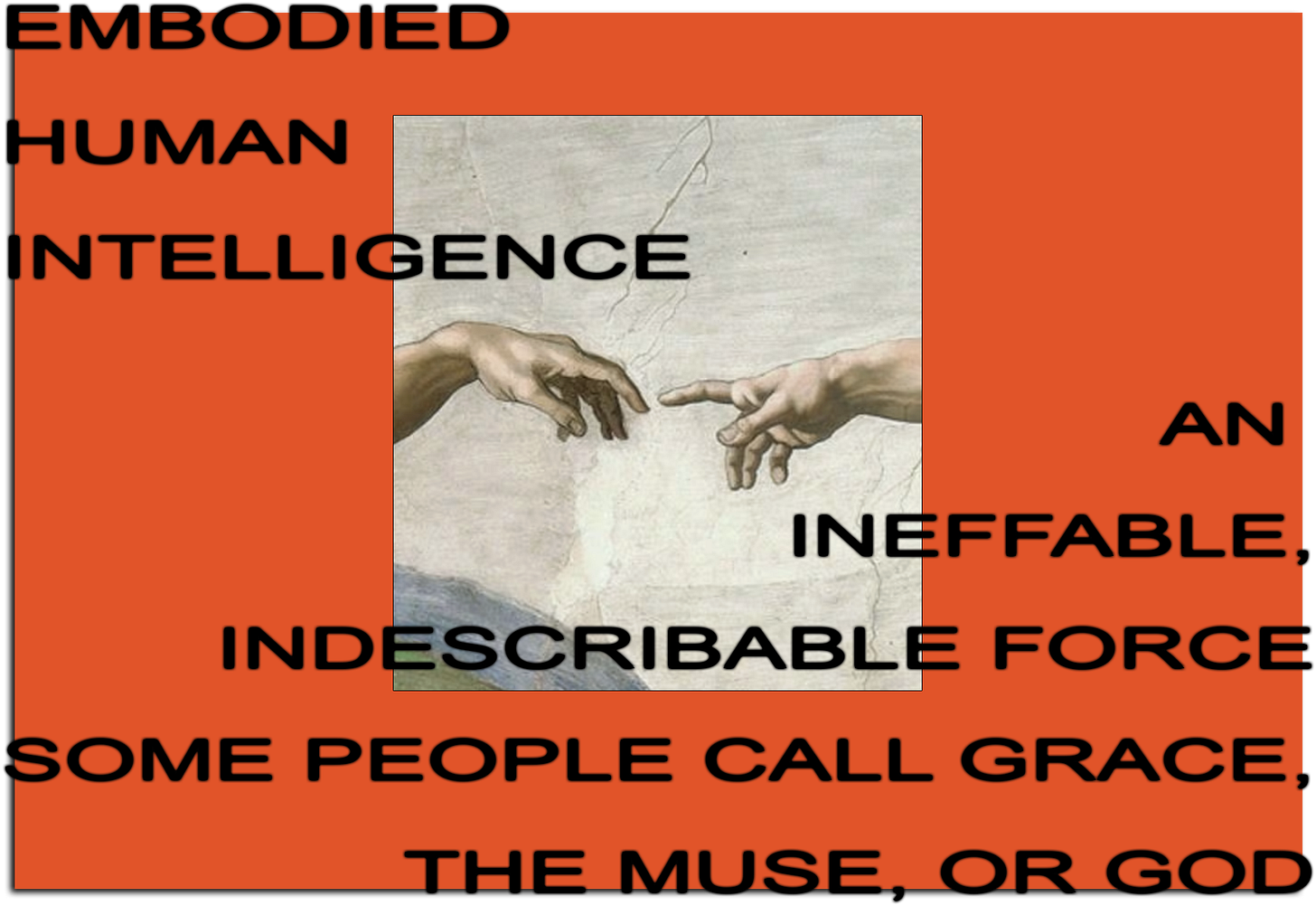Actually making things is fun
AI takes away the making
Blackbird Spyplane exists thanks to our readers. We don’t run any ads, we don’t use affiliate links on new clothes, we don’t do any spon. You’re the only people we owe anything, so we keep some of our best material for Classified Tier Subscribers. Upgrade today if you haven’t yet, support greatness and enjoy a better life in the inner sanctum — Jonah & Erin
Our interviews with Nathan Fielder, Cameron Winter and Geese, Adam Sandler, Brendan from Turnstile, Patrick Radden Keefe, MJ Lenderman, Issy Wood, Evan Kinori, Steven Yeun, Maya Hawke, Bon Iver, André 3000, Sandy Liang, Matty Matheson, Laraaji, Ryota Iwai from Auralee, Tyler, The Creator, John C. Reilly, Rashida Jones, Father John Misty, Kate Berlant, Clairo, Conner O’Malley & more are here.
Check out our monumental new list of the 50 Slappiest Shops across the Spyplane Universe.
Mach 3+ city intel for traveling the entire planet is here.
There’s a trove of rugs, cushions, lamps, ceramics and more in our Home Goods Index.
Every now and then, we get a cold pitch from someone who’s decided to spend part of the time they have on this planet working at an AI startup. They want to show us a tool, they say, that will revolutionize the work of making Blackbird Spyplane, or at least make it easier. Every time, we delete it — not interested. But when we got one of these pitches last week, I (Jonah) stopped to ponder why we’re not interested, and my thoughts turned to birthday cards.
When I was growing up, my parents were what people today call “freelance creatives,” but back then they just called themselves freelancers. My dad took pictures, my mom designed knitwear. They didn’t make a lot of money, and — with help from a series of rent-stabilized NYC apartments — they never let that shake their core conviction that a life spent making things was the kind of life they wanted to live. “You can get rich if all you want to do is get rich,” my mom, a law-school dropout, told me, but I’d only be happy if I did something that really mattered to me.
Plenty of children do ideological 180s from their parents, but I f--ked with my folks’ vision straightaway: I created my own comics, acted in plays, wrote short stories, shot movies with friends on a camcorder and, before any of that, drew birthday cards.
Store-bought cards were among the things my parents refused to spend money on, out of a combination of thrift and principle. To them, greeting-card companies like Hallmark traded in the crass commodification of human sentiment. To buy a card for somebody you cared about was, however well-intentioned, to put something inert, disenchanted and disposable in between you, your feelings, and the person you felt them for.
So when it came time for me to give someone a card — classmates, relatives — my mom broke out Bristol board, pens, markers and colored pencils: “It’ll mean a lot more if you draw your own.” And, no big surprise, people were indeed hyped to get a card I’d made, with motifs custom-tailored to their interests, by hand, just for them.
I still try to draw cards today, for Erin, for my parents, for friends, for friends’ kids. Above is one I made for Erin earlier this year, using some watercolor markers. Mostly I do them analog-style like this, but on occasion I’ve Photoshopped cards and printed them out. No matter the format, I’m proof that no great artistic talent is required. Quite the contrary, a lack of technical ability tends, with the hand-made card, to add to the overall charm.
And here’s the reason I bring this up: Drawing cards is not some time-consuming chore I’ve ever wanted to optimize, automate, or otherwise shortcut my way out of doing. It’s a satisfying, entirely voluntary way to spend my time. No one is forcing me to do it, and it feels good to do. It’s nice to just sit and draw for a while, and when I’m done, I’ve given deliberate form, however rough-hewn and funky, to my affection for someone — rather than putting something inert, disenchanted and disposable between us.
No one ever forced me to draw comics, either, to make movies with friends, or to go into magazine journalism and learn how to write profiles of people. Absolutely no one forced me and Erin to start this newsletter. No one forced us to do every janky Photoshop illustration we’ve ever published, spending God knows how many hours zoomed in on a collage at 1600%, tidying up rough edges with the lasso tool like some damn 🤠 digital cowboys.
We do these things because they give us pleasure, they make us feel connected to all kinds of Spyfriends, readers and makers alike — and because imagining things and then working to realize them is fun. Why would we ever want to automate that pleasure, and that sense of connection, out of our lives? Why would we want to automate imagination, and the work involved in bringing it to life?
When people bring up the specter of generative AI as relates to creative work, my mind goes in a few different directions. But the point that feels most salient is the simplest: Actually doing things is fun.
Recently my friend caught a screening of The Matrix on 35mm and, afterwards, told me about a trick shot the Wachowski sisters deployed where we see Morpheus and Neo’s reflection close-up in a doorknob. To hide the camera, they fitted it with a little coat and tie that matched Morpheus’s costume.
Wonderful. There’s something so pleasing about that solution — a bit of primitive, practical problem-solving that, when you know about it, only deepens the magic. As my buddy aptly put it, “That’s real hip-hop.”
Or take this moment from John Carpenter’s horror movie Christine, where a demonic car that’s been demolished by vandals supernaturally “heals” itself…
This is one of the most captivatingly beautiful 10-second stretches in the history of moving pictures, and making it required zero computers, just a combination of extreme ingenuity and a trick as basic as they come: Carpenter and his crew took a gleaming red & chrome Plymouth, lit it exquisitely, built a hydraulic rig to crush the car on film, then ran the film backwards.
For the audience, there’s a doubled pleasure. 1. The woozy spectacle of a crumpled car inflating itself, and 2. Our sense of how fun it must have been for people to devise, work through, and pull off such an elegant illusion.
In other words, we’re aware of an embodied human intelligence clicking into alignment with an ineffable, indescribable force that some people call grace, or the Muse, or God.
Christine came out in 1983. The Matrix came out in 1999. This kind of “in-camera” effects work has long since been edged out by digital techniques. And while I have a certain emotional preference for the former, I recognize that there are, of course, good and bad practical effects, and good and bad computer-generated ones.
A few years ago I wrote an NYT Magazine profile of the great David Fincher, who began his career building practical effects for Star Wars, then became a perfect example of a director whose embrace of digital post-production technology doesn’t diminish the force of his films. The reason it doesn’t is that Fincher never goes on autopilot, never takes a shortcut.
Same thing with a Bong Joon-ho, same thing with a James Cameron. Fincher works over every frame, and seeks out collaborators who will do the same. The result, even in an ocean of pixels, is that same palpable feeling of embodied human intelligence coming into phase with the ineffable.
This is distinct from the noisy, impersonal way that CG works in Marvel movies, and it’s a universe away from the dead, queasy feel of AI-generated images. Every frame of a Fincher movie feels more like Fincher — more like the human behind it — not more like computer.
AI boosters argue that, while generative technologies are new and shiny, they’re at root no different from the digital technologies an artist like Fincher uses, or the practical ones an artist like Carpenter used. They argue that AI is just another tool.
But I can’t get past the fact that, for something to count as a tool, it has to help you do something. Whereas generative AI’s core promise is that it takes away the doing. It reduces the creative act to a technically complex and yet nonetheless bumbling interaction between user prompts and a sludgy dataset of pillaged culture. It’s purpose-built for volume and churn — graceless, museless, godless.
We go to art to encounter other people. And that is not the encounter AI enables: it’s been designed, built and sold by businessmen who, at bottom, see other people as a problem to be engineered past (“what if workers and girlfriends were AI?”) or exploited at scale (“what if we could sell lonely people AI girlfriends?”)
If any great art manages to emerge from generative AI, it will have to grapple with and find some way to transcend those demonic, in-built prerogatives. I’m not sure that’s possible. Even if it is, I’m doubtful it’s worth it. In any case, I’ll keep drawing birthday cards.
The B.L.I.S.S. List — a handy rundown of Beautiful Life-Improving Spyplane Staples, from incense to socks — is here.
Our new Cool Mom Style Guide is here.
We don’t run ads, we refuse gifts, and we don’t use affiliate links when we cover new clothes. We do use them for one-off secondhand gems we find on eBay, Etsy, and TRR, plus books on the independent bookseller Bookshop. We laid out our position on affiliate links and spon here.
“The edges of the human are dissolving,” as the arts writer and Spyfriend Dean Kissick recently put it at Spike. We see this nowhere more clearly than in what he calls the rise of what he calls the Vulgar Image: “the expression of machines, and those who have had their brains scrambled by machines.” Dean calls AI “another sort of neo-Surrealist automatic writing over which the author has limited control. It is an expression of their unconscious by code, and at the same time an expression of the great collective unconscious contained in deep datasets and language models.” Here.
“We’re entering into a time when authorship is being deeply questioned and contested,” Spyfriend Oneohtrix Point Never a.k.a. Daniel Lopatin said in an interview about his new album, published at Tone Glow yesterday. “There’s a lot of arrogance in Silicon Valley about how little we need art or individualism. There are a lot of arguments to be made about all the great gains that were made with 20th-century recorded music by removing authorship. So much of what I love about electronic music or techno is the removal of the author, the way it can become a communal experience. And I don’t know if I can fully address this in one fell swoop, but the records I like to listen to are ones that have a lot of personality. That still matters to me…like, ‘This is how I see the moment, this is how I see my life.’ Otherwise it’s the ennui of life without personality—it’s just this world without any distinction, without any perspective.” Here.









Damn, this is why I - a man who hasn't bought a new pair of trousers in a decade - am a subscriber. Thank you.
I think about the CEO of an AI song generator A LOT. He said, “It’s not really enjoyable to make music now,” he said. “It takes a lot of time, it takes a lot of practice, you need to get really good at an instrument or really good at a piece of production software.”
>>>>>>>>>>>>>>>>It's not enjoyable to learn or make things<<<<<<<<<<<<<<
This is profoundly anti-human. And it is bound to fail.